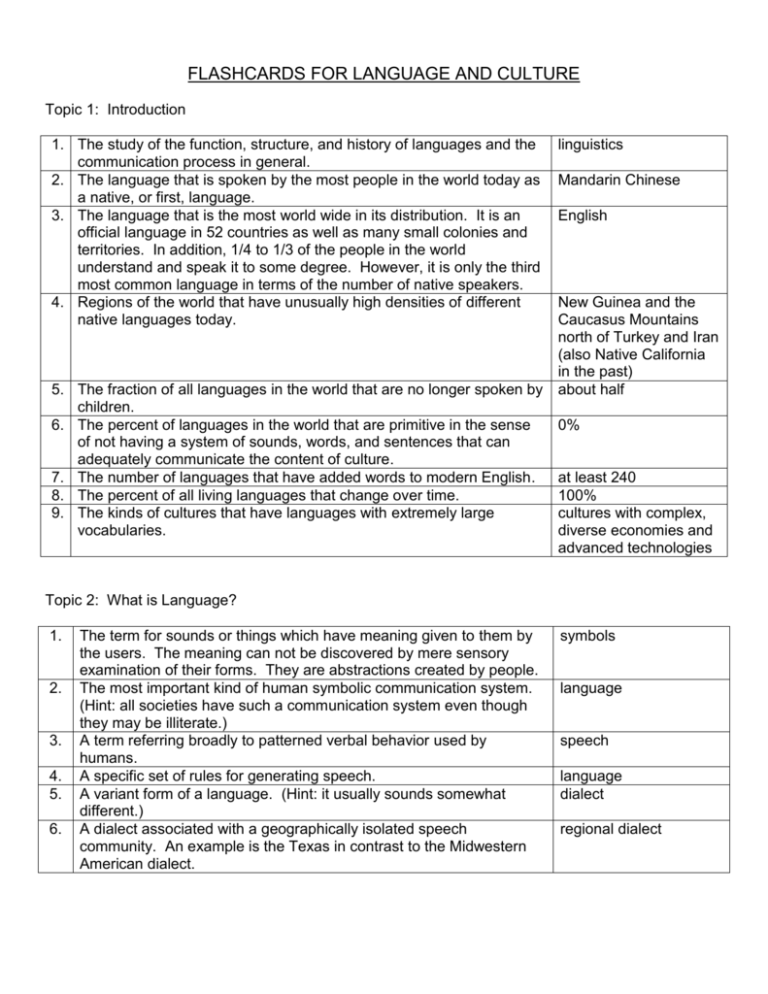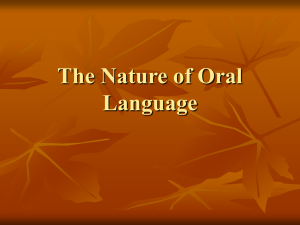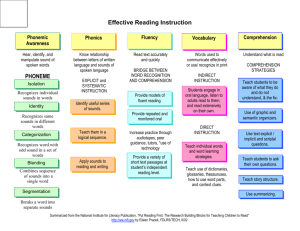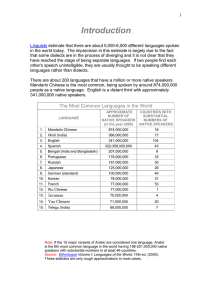
FLASHCARDS FOR LANGUAGE AND CULTURE
Topic 1: Introduction
1. The study of the function, structure, and history of languages and the
communication process in general.
2. The language that is spoken by the most people in the world today as
a native, or first, language.
3. The language that is the most world wide in its distribution. It is an
official language in 52 countries as well as many small colonies and
territories. In addition, 1/4 to 1/3 of the people in the world
understand and speak it to some degree. However, it is only the third
most common language in terms of the number of native speakers.
4. Regions of the world that have unusually high densities of different
native languages today.
5. The fraction of all languages in the world that are no longer spoken by
children.
6. The percent of languages in the world that are primitive in the sense
of not having a system of sounds, words, and sentences that can
adequately communicate the content of culture.
7. The number of languages that have added words to modern English.
8. The percent of all living languages that change over time.
9. The kinds of cultures that have languages with extremely large
vocabularies.
linguistics
Mandarin Chinese
English
New Guinea and the
Caucasus Mountains
north of Turkey and Iran
(also Native California
in the past)
about half
0%
at least 240
100%
cultures with complex,
diverse economies and
advanced technologies
Topic 2: What is Language?
1.
2.
3.
4.
5.
6.
The term for sounds or things which have meaning given to them by
the users. The meaning can not be discovered by mere sensory
examination of their forms. They are abstractions created by people.
The most important kind of human symbolic communication system.
(Hint: all societies have such a communication system even though
they may be illiterate.)
A term referring broadly to patterned verbal behavior used by
humans.
A specific set of rules for generating speech.
A variant form of a language. (Hint: it usually sounds somewhat
different.)
A dialect associated with a geographically isolated speech
community. An example is the Texas in contrast to the Midwestern
American dialect.
symbols
language
speech
language
dialect
regional dialect
7.
8.
9.
10.
11.
12.
13.
A dialect spoken by a speech community that is socially isolated from
others. These kinds of dialects are mostly based on class, ethnicity,
gender, age, or particular social situations. “Black English” in North
America is an example.
The term for a simplified, makeshift language that develops to fulfill
the communication needs of people who have no language in
common but who need to occasionally interact for commercial and
other reasons. Such languages combine a limited amount of the
vocabulary and grammar of the different languages. People who use
these makeshift languages also speak their own native language.
The linguistic term for what Chinook was. (Hint: it was used by
Indians from different cultures on the Northwest Coast of North
America to communicate with each other.)
The general term for a pidgin language that has become the mother
tongue of a population. In Haiti, for example, a French-African pidgin
became this sort of language. It is spoken in that nation today by the
majority of the population as their principle or only language.
The phenomenon in which different dialects of a language or different
languages are spoken by a person in different social situations.
People who do this may quickly switch back and forth between
dialects or languages, depending on the person they are talking to at
the time.
The linguistic term for what Gullah was. (Hint: it was used on the
outer banks of Georgia and South Carolina by former African slaves.
It evolved from a form of pidgin English.)
The term for a common social dialect spoken by many African
Americans.
social dialect
pidgin
pidgin
creole
diglossia
creole
Black English or
Ebonics
Topic 3: Analysis of Language
1.
2.
3.
4.
5.
6.
7.
The part of language analysis that is concerned with the sounds of a
language.
The part of language analysis that is concerned with how the sounds
are used to make sense. It consists of morphology and syntax.
The smallest unit of sound that can be altered to change the meaning
of a word. These units of sound do not have meaning by themselves.
The initial sound in the words bit, kit, sit, and pit are examples.
The number of phonemes that English usually uses.
The kinds of verbal sounds that the San languages of southwest
Africa use that are not found in English or most other languages
elsewhere. (Hint: the language of the Ju/'hoansi people uses these
sounds.)
The study of how sounds are combined by language into larger units
called morphemes.
The general term for a standardized set of rules that determine how
words should be combined to make sense to speakers of a
language. Grammar consists of these rules and morphology.
phonology
grammar
phoneme
40
click sounds used as
consonants
morphology
syntax
8.
The smallest combination of sounds that have meaning and cannot
be broken into smaller meaningful units. The English words “cow”
and “boy” are examples. Words can be one or more of these units.
9. The general term for a morpheme that has meaning but can not stand
alone. The prefix “dis” in the English word “disable” is an example.
10. The primary way in which Latin derived languages, such as Spanish,
French, and Italian change the meaning of a sentence.
11. The primary way in which the meaning of a sentence is changed in
English.
12. The primary way in which the meaning of a sentence is changed in
Mandarin Chinese.
13. The number of languages in which speakers must memorize all
possible sentences that can be created. In other words, simply
learning the rules for creating sentences is not adequate to be able to
speak and understand other people using these languages.
morpheme
bound morpheme
by changing the
endings of words (i.e.,
suffixes).
by changing the word
order
by changing the tone of
syllables in words
zero
Topic 4: Learning Language
1. The way most linguists believe that children learn their native
language.
2. The age at which most children have learned to use about three
words consisting of single morphemes, such as “eat”, “mom”, and
“more”.
3. The kind of syntax error that young children learning English as their
native language often make with the past tense of verbs (e.g., “give”
becomes “gived”, “take” becomes “taked”, “eat” becomes “eated”).
4. The term for what happens when learning a second language can be
affected by the patterns of the first language (e.g., blending of
phonemes from the different languages).
primarily by listening to
and trying to
communicate with adult
speakers
one
over regularize the
common rule (i.e.,
inappropriately apply it
to irregular words)
linguistic interference
Topic 5: Language and Thought Processes
1. The early 20th century idea that language predetermines what we see Sapir-Whorf hypothesis
in the world around us. In other words, we see the real world only in
the terms and categories of our language. This hypothesis was later
mostly rejected by anthropologists.
2. The field of anthropology that tries to learn about how people in
ethnoscience
different cultures categorize and interpret things in their environment.
The focus is on emic categories.
3. The term referring to a classification of things according to some
external system of analysis brought in by a visitor to another society.
(Hint: this is the approach of biology in using the Linnaean
classification system to define new species. It assumes that
ultimately, there is an objective reality and that is more important than
cultural perceptions of it.)
4. The term referring to a classification of things according to the way in
which members of a society classify their own world. In other words,
this is the way their culture and language divide up and interpret
reality.
5. A term referring to sexual identity as male or female.
etic category
emic category
gender
Topic 6: Hidden Aspects of Communication
1. The term for auxiliary communication methods used by people talking
to each other (e.g., variations in tone and character of voice along
with non-verbal forms of communication).
2. The part of non-verbal communication consisting of gestures,
expressions, and postures. (Hint: it is also known as body language.)
3. The term for the kind of paralanguage that includes interaction
distance and other culturally defined uses of space.
4. The age at which North American children begin to master the subtle
cultural aspects of time, such as when one should arrive at a party or
a business appointment.
5. The common attitude In North America in regards to adults touching
each other except in moments of intimacy or formal greeting (hand
shaking or hugging).
6. The general functions and purposes of clothing around the world.
7. The linguists general term for the distance our bodies are physically
apart while talking with each other. (Hint: this is an aspect of
proxemics.)
Copyright © 2004 by Dennis O'Neil. All rights reserved.
paralanguage
kinesics
proxemics
about 12
It is discouraged,
especially for men
protection from the
elements, modesty,
supernatural protection,
and communication of
status, intentions, and
other messages
interaction distance









